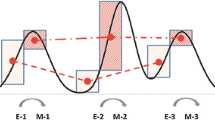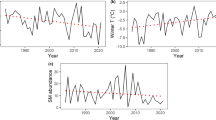Understanding the effects of environmental factors on the dynamics of animal populations is one of the major challenges for population biologists. In particular, the impact of climate and weather has been the focus of many studies during the last years (e.g., Lima and Jaksic 1998; Milner et al. 1999; Stenseth 1999; Yoccoz and Stenseth 2000; Aars and Ims 2002; Lande et al. 2003). However, data on specific effects of the weather on different vital rates are rare, because, in small mammals in particular, individually based studies are difficult to conduct, and long-term datasets are needed for obtaining reliable results.
Access this chapter
Tax calculation will be finalised at checkout
Purchases are for personal use only
Preview
Unable to display preview. Download preview PDF.
Similar content being viewed by others
References
Aars J, Ims, RA (2002) Intrinsic and climatic determinants of population demography: the winter dynamics of tundra voles. Ecology 83:3449–3456.
Andersson M, Borg B, Meurling P (1979) Biology of the wild rabbit, Oryctolagus cuniculus, in southern Sweden. II. Modification in the onset of breeding, in relation to weather conditions. Swedish Wildl Res (Viltrevy) 11:129–137.
Bell DJ, Webb NJ (1991) Effects of climate on reproduction in the European wild rabbit (Oryctolagus cuniculus). J Zool 224:639–648.
Calvete C, Estrada R, Angulo E, Cabezas-Ruiz S (2004) Habitat factors related to wild rabbit conservation in an agricultural landscape. Landscape Ecol 19:531–542.
Cowan DP (1985) Coccidiosis in rabbits In: Mollison D, Bacon P (eds) Population dynamics and epidemiology of territorial animals. I.T.E. Merlewood, Cumbria, pp 25–27.
Cowan DP (1987) Aspects of the social organisation of the European rabbit (Oryctolagus cuniculus). Ethology 75:197–210.
Crawley MJ (1983) Herbivory: the dynamics of animal-plant interactions. Blackwell Science, Oxford.
Dudzinski ML, Mykytowycz R (1960) Analysis of growth rates of an experimental colony of wild rabbits, Oryctolagus cuniculus (L.). CSIRO Wildl Res 5:102–105.
Erlinge S, Göransson G, Högstedt G, Jansson G, Liberg O, Loman J, Nilsson IN, von Schantz T, Sylvén M (1984) Can vertebrate predators regulate their prey? Am Nat 123:125–133.
Flux JEC (1967) Reproduction and body weights of the hare Lepus europaeus Pallas in New Zealand. NZ J Sci 10:357–401.
Flux JEC (1994) World distribution. In: Tompson HV, King CM (eds) The European rabbit. The history of a successful colonizer. Oxford University Press, Oxford, pp 9–21.
Gonçalves H, Alves PC, Rocha A (2002) Seasonal variation in the reproductive activity of the wild rabbit (Oryctolagus cuniculus algirus) in a Mediterranean ecosystem. Wildl Res 29:165–173.
Hamilton WJ (1940) Breeding habits of the cottontail rabbit in New York State. J Mammal 21:8–11.
Helle E, Kauhala K (1995) Reproduction in the raccoon dog in Finland. J Mammal 76:1036–1046.
Hudson R, Müller A, Kennedy GA (1995) Parturition in the rabbit is compromised by daytime nursing: the role of oxytocin. Biol Reprod 53:519–524.
Katzner TE, Parker KL, Harlow HH (1997) Metabolism and thermal response in winter-acclimatized pygmy rabbits (Brachylagus idahoensis). J Mammal 78:1053–1062.
King DR, Wheeler SH, Schmidt GL (1983) Population fluctuations and reproduction of rabbits in a pastoral area on the coast north of Carnarvon, W.A. Austral Wildl Res 10:97–104.
Kline PD (1963) Notes on the biology of the jackrabbit in Iowa. Proc Iowa Acad Sci 70:196–204.
Lande R, Enden S, Sæther BE (2003) Stochastic population dynamics in ecology and conservation. Oxford Series in Ecology and Evolution. Oxford University Press, Oxford.
Lima M, Jaksic FM (1998) Population variability among three small mammal species in the semiarid Neotropics: the role of density-dependent and density-independent factors. Ecography 21:175–180.
Loison A, Langvatn R, Solberg EJ (1999) Body mass and winter mortality in red deer calves, distengling sex and climate effects. Ecography 21:175–180.
Marboutin E, Hansen K (1998) Survival rates in a nonharvested brown hare population. J Wildl Manage 62:772–779.
Milner J, Elston DA, Albon SD (1999) Estimating the contribution of population density and climatic fluctuations to interannual variation in survival of Soay sheep. J Anim Ecol 68:1235–1247.
Myers K, Bults HG, Gilbert N (1977) Stress in the rabbit, Part XI in the series “The biology of the wild rabbit in climatically different regions in eastern Australia”. Austral J Ecol 10:103–136.
Myers K, Poole WE (1961) A study of the biology of the wild rabbit, Oryctolagus cuniculus (L.), in confined populations. II. The effects of season and population increase on behaviour. CSIRO Wildl Res 6:1–41.
Myers K, Poole WE (1962) A study of the biology of the wild rabbit, Oryctolagus cuniculus (L.), in confined populations. III. Reproduction. Austr J Zool 10:225–267.
Myers K, Poole WE (1963) A study of the biology of the wild rabbit, Oryctolagus cuniculus (L.), in confined populations. V. Population dynamics. CSIRO Wildl Res 8:166–203.
Mykytowycz R (1958) Social behaviour of an experimental colony of wild rabbits, Oryctolagus cuniculus (L.). I. Establishment of the colony. CSIRO Wildl Res 3:7–25.
Mykytowycz R (1962) Epidemiology of coccidiosis (Eimeria spp.) in an experimental population of the Australian wild rabbit, Oryctolagus cuniculus (L.). Parasitology 52:375–395.
Richardson BJ, Wood DH (1982) Experimental ecological studies on a subalpine rabbit population I. Mortality factors acting on emergent kittens. Austr Wildl Res 9:443–450.
Rödel HG (2000) Low temperature effects and social influences on physiological condition of subadult wild rabbits. In: Heldmaier G, Klingenspor M (eds) Life in the cold. Springer, Berlin Heidelberg New York, pp 511–518.
Rödel HG (2005) Winter feeding behaviour of European rabbits in a temperate zone habitat. Mamm Biol 70:300–306.
Rödel HG, Bora A, Kaetzke P, Khaschei M, Hutzelmeyer H, Zapka M, von Holst D (2005) Timing of breeding and reproductive performance of female European rabbits in response to winter temperature and body mass. Can J Zool 83:935–942.
Rödel HG, Bora A, Kaetzke P, Khaschei M, Hutzelmeyer H, von Holst D (2004a) Over-winter survival in subadult European rabbits: weather effects, density-dependence, and the impact of individual characteristics. Oecologia 140:566–576.
Rödel HG, Bora A, Kaiser J, Kaetzke P, Khaschei M, von Holst D (2004b) Density-dependent reproduction in the European rabbit: a consequence of individual response and age-dependent reproductive performance. Oikos 104:529–539.
Schröpfer R, Bodenstein C, Seebass C (2000) A predator-prey-correlation between the European polecat Mustela putoris L., 1758 and the wild rabbit Oryctolagus cuniculus (L., 1758). Z Jagdwiss 46:1–13.
Soriguer RC, Rogers PM (1981) The European wild rabbit in Mediterranean Spain. In: Myers K, MacInnes CD (eds) Proceedings of the world lagomorph conference, Guelph, Ontario, pp 600–613.
Stenseth NC (1999) Population cycles of voles and lemmings: density dependence and phase dependence in a stochastic world. Oikos 87:427–461.
Stodart E (1968) Coccidiosis in wild rabbits, Oryctolagus cuniculus (L.), at four sites in different climatic regions in Eastern Australia. I. Relationship with age of the rabbit. Austr J Zool 16:69–85.
Trout RC, Langton S, Smith GC, Haines-Young RH (2000) Factors affecting the abundance of rabbits (Oryctolagus cuniculus) in England and Wales. J Zool 252:227–238.
von Holst D (1998) The concept of stress and its relevance for animal behavior. Adv Study Behav 2:71–131.
von Holst D, Hutzelmeyer HD, Kaetzke P, Khaschei M, Rödel HG, Schrutka H (2002) Social rank, fecundity and lifetime reproductive success in wild European rabbits. Behav Ecol Sociobiol 51:245–254.
Wallage-Drees JM (1986) Seasonal changes in the condition of rabbits, Oryctolagus cuniculus (L.), in a coastal dune habitat. Z Säugetierkd 51:26–36.
Wallage-Drees JM (1989) A field study of seasonal changes in circadian activity of rabbits. Z Säugetierkd 54:22–30.
Wheeler SH, King DR (1985) The European rabbit in south-western Australia II. Reproduction. Austr Wildl Res 12:197–212.
Wright HM, Conaway CH (1961) Weather influences on the onset of breeding in Missouri cottontails. J Wildl Manage 25:87–89.
Yoccoz NG, Stenseth NC (2000) Understanding the dynamics of bank vole populations, demographic variability, stochasticity and density dependence. Polish J Ecol 48:75–86.
Author information
Authors and Affiliations
Editor information
Editors and Affiliations
Rights and permissions
Copyright information
© 2008 Springer-Verlag Berlin Heidelberg
About this chapter
Cite this chapter
Rödel, H.G., Von Holst, D. (2008). Weather Effects on Reproduction, Survival, and Body Mass of European Rabbits in a Temperate Zone Habitat. In: Alves, P.C., Ferrand, N., Hackländer, K. (eds) Lagomorph Biology. Springer, Berlin, Heidelberg. https://doi.org/10.1007/978-3-540-72446-9_8
Download citation
DOI: https://doi.org/10.1007/978-3-540-72446-9_8
Publisher Name: Springer, Berlin, Heidelberg
Print ISBN: 978-3-540-72445-2
Online ISBN: 978-3-540-72446-9
eBook Packages: Biomedical and Life SciencesBiomedical and Life Sciences (R0)




